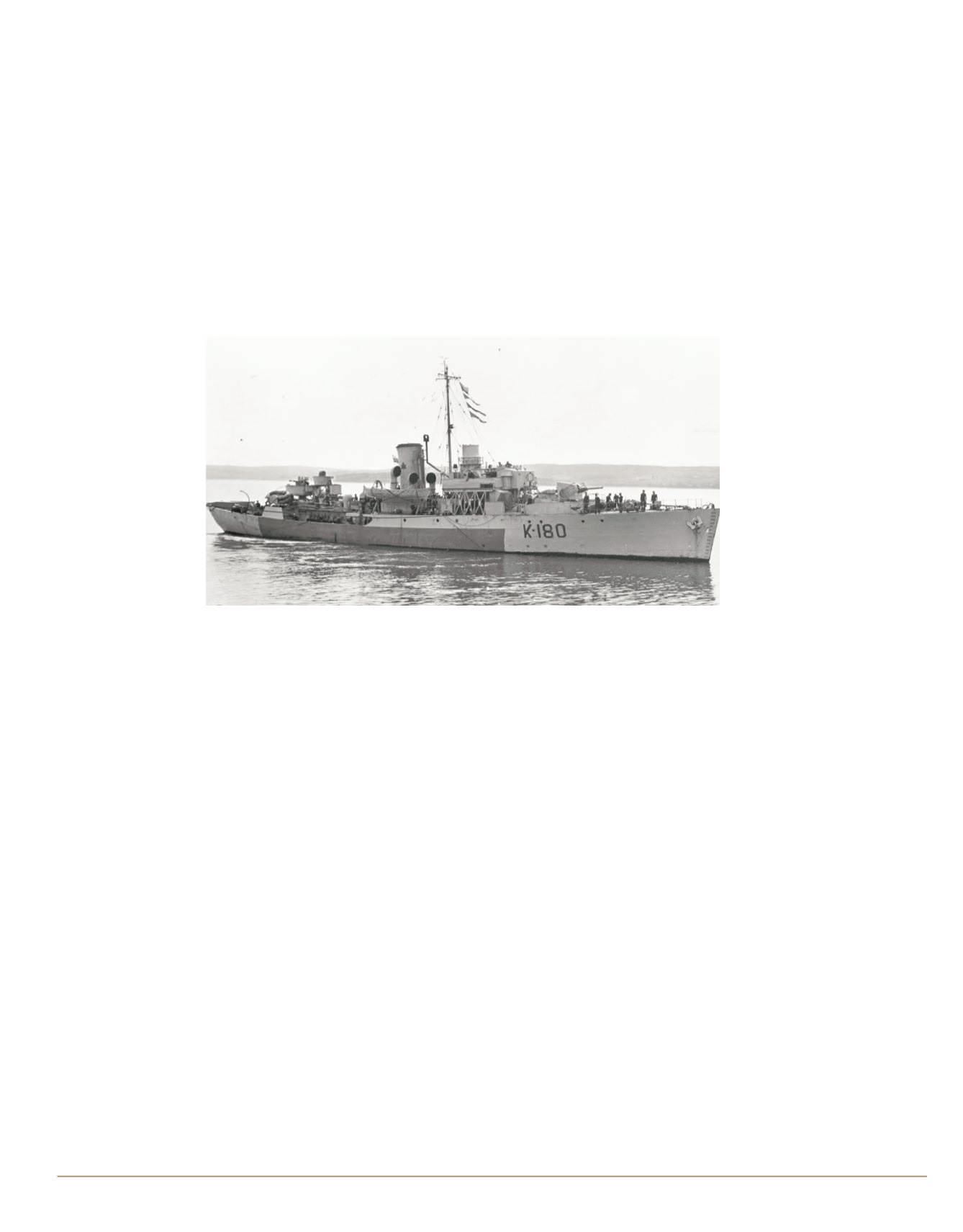
It is fitting that the townknownasHen&Chick-
ens Harbour
was re-named after one of Britain’s most valiant
sailors,Vice-AdmiralCuthbertCollingwood,1st BaronofCollingwood
who wasbornon26September1748 inNewcastleUponTyne, Eng-
land. Hewasa friend to thegreat hero, LordHoratioNelson,whowas
killedduring themost decisivebattleever fought by theRoyalNavyat
Trafalgar.
The battlewas fought against acombined fleetmainlyof Spanishand
French vessels under thecommandof Admiral Villeneuvewhich sailed
fromCadiz inOctober1805. Theywerecloselydoggedby theBritish.
At Trafalgar, theBritishboredown in twoseparate lineson thecrescent-
shaped line thatVilleneuvehadmanoeuvred into. Oneof the lineswas
ledbyNelson inHMSVictory and theother byCollingwood inHMS
RoyalSovereign. Collingwood’sshipwas fasteras ithad recentlybeen
re-fitted with a smooth
copper lined hull.
Collingwoodwas thefirst
to engage the enemy
and Nelson said of his
friend and colleague,
“See…See how that
noble fellow Colling-
woodcarrieshisship into
action!” At almost the
same time,Collingwood
said tohisship’scaptain,
as if responding to his
commander,“What
wouldNelsongive tobe
here?”
Once theFrenchandSpanish fleetshadbeen routedby theoverwhelm-
ingsuperiorityofBritishseamanship, LordNelsonwaskilled inbattleon
thedeckof his flagship. Shot byaFrench sniperon21October1805,
it is reported that his final words, murmured to ship’s surgeonWilliam
Beattywere, “ThankGod I havedonemyduty.”
Collingwoodassumedcommandof theBritish fleet andafter thecostly
battle he disregardedNelson’s command that the ships be anchored
due to theon-cominggale. TheVice-Admiral’sdecisionwasawiseone
foralthoughanumberof capturedvessels inEnglish towweresmashed
upon the rocky shorebypounding stormy seas, not a singleBritish ship
was lost.
Following thebattleof Trafalgar,Collingwood,whosehealthwasdete-
riorating,made several petitions tohis superiors tobeallowed to return
tohisbelovedhome inMorpeth,England. Itwasnotuntil1809 that the
senioradmiraltygranted the requestas theyhadpreviouslyargued that
anofficer of Collingwood’s stature couldnot be relieved. By this time,
themanwasalarmingly illandon7March1810hediedonboard the
ship,VilledeParis,as it sailed towardEngland. Hewas interredbeside
his friend,HoratioNelson, inacrypt in London’sSt. Paul’sCathedral.
Collingwoodwasa remarkableofficerwhoalsoshowedgreat compas-
sion tohismen. Opposed to theRoyalNavy’smost repressive formsof
discipline, including flogging,hewasknown tohissubordinates, includ-
ing the lowlyordinary seamen, as “father.”
Eighty-two years after Vice-Admiral Cuthbert Collingwoodwas laid to
rest,Messrs. J.D.SilcoxandS.D.Andrews formed theCollingwoodDry
Dock, ShipbuildingandFoundryCompany.
During theGreatWar, laterknownasWorldWar I,workers inColling-
woodproduced five tankers for ImperialOil toassistwith theconflict ef-
fort. At this time the town granted a bonus of $50,000 to the
shipbuildingcompany toestablishsteel shipbuilding facilitiesand toex-
pand thedrydock to550 feet.
Equipmentwas also re-tooled so that 18-pound shrapnel and4.5 inch
high explosive shells couldbe produced. Because of the shortage of
maleworkers, manywho had left Canada for the slaughter fields of
FranceandBelgium,womenwerehiredon for the first timeasproduc-
tionworkers.
Following theendofhostilities, theshipyards returned tohighproduction
building civilian ships toassist with the re-construction of aworld shat-
teredbywar. Theyardswerehit hardduring theGreat Depressionof
the1930’sand theworkforcewas reduced toaskeletonstaff. Evenbe-
fore the next conflict broke out in Europe in 1939, war plannerswho
could see thecataclysmicdirection that theworldwas yet againheading,
demanded that shipsbebuilt for thealmostnon-existentCanadianNavy.
Althoughsomeminesweepers,designed toclearharboursofdeadlyex-
plosivesanda fewotherauxiliary shipswerebuiltatCollingwood,dur-
ing the40’s, themost produced
vesselwas theCorvette.
The name “Corvette”was origi-
nally created by the French to
designate a small sail-powered
fightingshipand the termwas for
a time used by the Royal Navy
but was discontinued in 1877.
During thehastypreparations for
the secondon-comingEuropean
conflagration, it was Winston
Churchill who gave new life to
theCorvetteso that itwouldserve
toprotect theEnglishcoastline.
Of the208 ships that were built
at the Collingwood Shipyards,
duringWorldWar II,23warships,mostly small,pluckyCorvetteswere
constructed for the Royal CanadianNavy, The Royal Navy and the
UnitedStatesNavy.
Corvetteswere named “flower class” because the Royal Navy chris-
tened their shipsaftervarious floral varieties,while inCanada, theships
werenamedafter towns. Thenamingof the shipswas the suggestionof
Admiral PercyW.Nelles so that communities that produced thevessels
couldbe recognized. Other shipswerecommissionedwith the financial
assistanceof locales thatwouldbear the ship’s name. HMCSColling-
woodwas launched secretlyon27 July1940andwas commissioned
on19November, entering serviceas the first CanadianCorvetteand
givenpennant numberK180.
In January1941, after completing her work-up, HMCSCollingwood
joined theHalifaxForcewhereshe remaineduntilMay. In June, shewas
transferred to theNewfoundland Escort Force, movingwith ships be-
tweenSt. John’sand Iceland. The shipwasapartof theconvoyprotec-
tion squadron that escortedmerchant vessels carryingmateriel vital to
thewar effort to Englandduring the earlywar yearswhen Britain did
not control the seas. Instead, the rovingbandofGerman submarines,
organized into“WolfPacks,”nearlydecimatedalliedshippingandGer-
man submariners referred to this as, “TheHappy Time.” Losses among
thealliedmerchantmenwasstaggeringas theNaziU-boatsentered the
convoysalmost unimpededand itwasup to the small, slow, and lightly
armedcorvettes todowhat theycould in theNorthAtlantic. Thecivilian
seamen, of theMerchantMarinewere hit with devastating casualties
andmore thanaquarter of thesemendid not live to see victory in Eu-
rope. Sixty-eight Canadianmerchant shipswere lost in theNorthAt-
lanticand1,148menperishedat sea.
HMCSCollingwoodwasCanada's firstcorvetteofWorldWar II,
the tiny, uncomfortable, generationofwarshipsdescribed
byNicholasMonsarrat in ‘TheCruel Sea’ as the
trueheroesof theBattleofAtlantic.
HMCSCollingwoodwas launchedsecretlyon27July1940
108
|
COMMUNITY
|
HISTORY


